Full-body workouts at home have a number of benefits:
- They allow you to train every major muscle group several times per week
- They tend to be less fatiguing than body-part splits (where you do multiple exercises for a single muscle group, like your chest).
- They’re a fun way to break up the monotony of training at home (you get to do a variety of exercises in every workout)
In this article, you’ll learn my three favorite at-home full-body workout routines for maintaining and gaining muscle and strength:
- Bodyweight
- Exercise bands
- Dumbbells
Which of the three workout routines you choose depends on your goals and equipment.
If you just want to maintain your strength and muscle mass and don’t want to buy any workout equipment, the bodyweight full-body workout routine will fit the bill.
If you want to gain muscle and strength while training at home with minimal investment, you’ll want to buy some exercise bands and follow that routine.
And if you want to get the best workout possible without buying a fully-equipped home gym, get a set of dumbbells and follow the full-body dumbbell workout routine.
My Top 5 At-Home Full-Body Workout Tips
Before we get into the workout routines themselves, here are a few tips to help you get the most out of your training.
1. Push, pull, and squat in every workout.
There are over 200 muscles in your body, but so long as each of your workouts includes a pushing exercise, a pulling exercise, and a squatting exercise, you can be sure you’re training all of the major ones.
You also want to include vertical (up and down) and horizontal (back and forth) pushing and pulling exercises in every workout.
For example, a shoulder press is a vertical pushing exercise, whereas a dumbbell bench press is a horizontal pushing exercise. A seated exercise band row is a horizontal pulling exercise, whereas a chin-up is a vertical pulling exercise.
This ensures your biceps, triceps, abs, and other smaller muscles groups all get attention and you don’t develop any muscle imbalances.
2. Use compound exercises to train your whole body.
When you’re working out with minimal equipment and trying to train every major muscle group in each workout, compound exercises are the way to go.
These are exercises that involve multiple joints and muscle groups, and thus offer the greatest muscle-building benefits in the least amount of time.
In these workouts, you’ll focus on exercises like push-ups, chin-ups, Bulgarian split squats, and rows; and forgo less time efficient (though still valuable) exercises like triceps kickbacks and curls.
3. Make your workouts harder over time.
If you’re following the bodyweight full-body workout routine, add reps to each set until you can do 20 reps per set for an exercise, and then switch to a more challenging variation of that exercise.
For example, once you can do 3 sets of 20 reps of regular push-ups, switch to diamond push-ups.
If you’re following either the exercise band or dumbbell workout routine, make your workouts more challenging by using thicker bands or heavier weights over time.
4. Buy exercise bands or dumbbells if you plan on doing full-body workouts at home for more than a month.
You can maintain your muscle and strength for a month or so with just bodyweight exercises, but unless you’re brand new to strength training, you’ll begin to drag anchor if you go much longer than this without external resistance.
So, if you’ll be working out at home for a while, spring for some good bands or dumbbells, and ideally, both.
And then do try to get back in the gym as soon as you can if you want to make faster progress in your fitness (unless you have a proper home gym setup, that is).
While you can gain muscle and strength by doing full-body workouts at home, you’ll gain a lot more if you can train with barbells, heavier dumbbells, and a few machines. Think of your home workouts as an effective stopgap until you can get back to the iron.
5. (Optional) Use supersets to finish your full-body workouts faster.
To make your at-home full-body workouts more time-efficient without compromising performance, you can alternate between exercises that train different muscle groups (a technique known as “supersetting”).
My favorite way to implement supersets are known as antagonist paired sets, which involve alternating between two exercises that train different muscle groups and resting longer than normal between sets than regular supersets.
For example, you could do a set of push-ups (which train your chest, shoulders, and triceps), rest a minute, and then do a set of chin-ups (which train your back and the biceps), and rest another minute. Then, you’d keep alternating between the two exercises until you’ve finished all of your sets for both exercises.
This allows you to use the sets for one exercise as rest periods for another (your “chin-up muscles” are resting while your “push-up muscles” are working, and vice versa). As a result, you don’t have to rest as long in between sets, which helps you finish your workouts faster.
At-Home Full-Body Workout Routine with Bodyweight
This full-body workout routine trains all of your major muscle groups without the need for equipment.

Here’s how to do each exercise:
Push-up
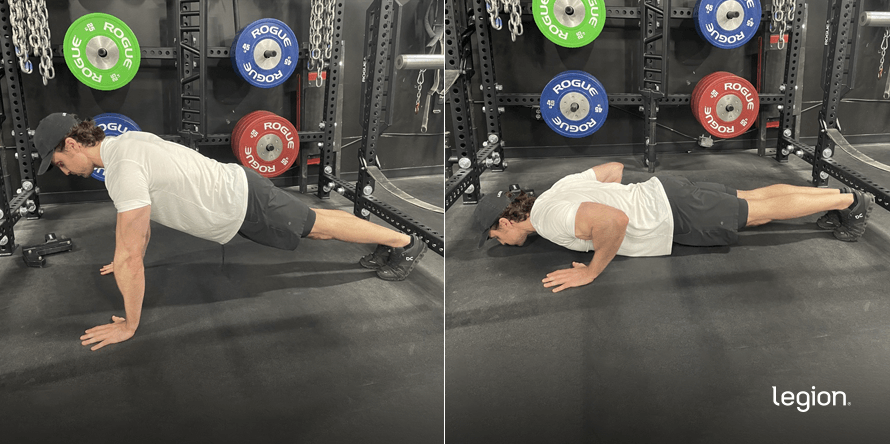
Get on all fours and place your hands slightly wider than shoulder-width apart. Extend your legs behind you, so that your body weight is supported on your hands and toes, and your body forms a straight line from your head to your feet (don’t lift up your butt or let your hips sag).
Keeping your back straight, lower your chest to the floor, then push your body up and return to the starting position.
Chin-up
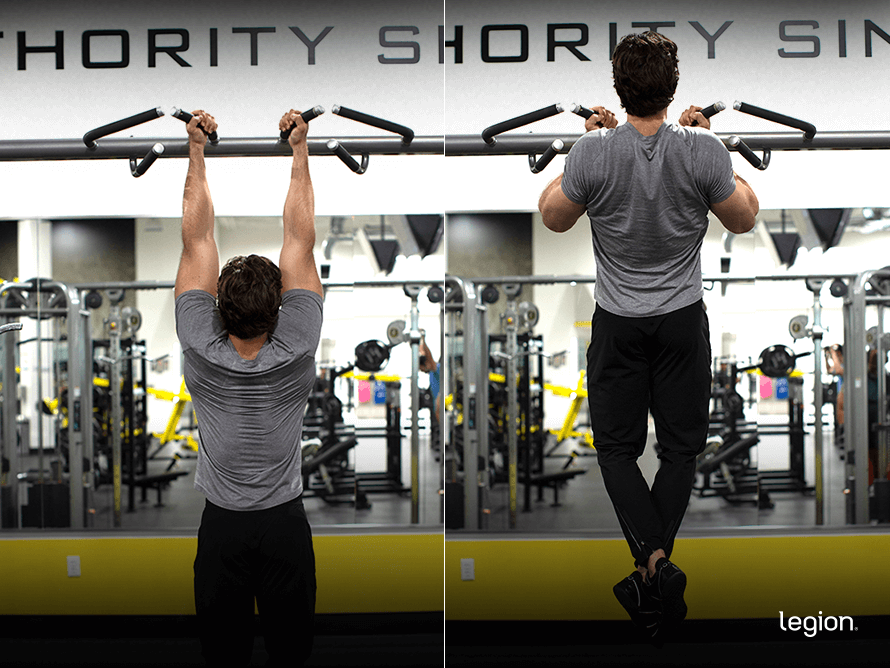
Grab a chin-up bar with your palms facing you and about shoulder-width apart and your arms straight. Without swinging your feet or knees, pull your body upward until your chin rises above your hands, then lower yourself to return to the starting position.
Bodyweight Bulgarian Split Squat
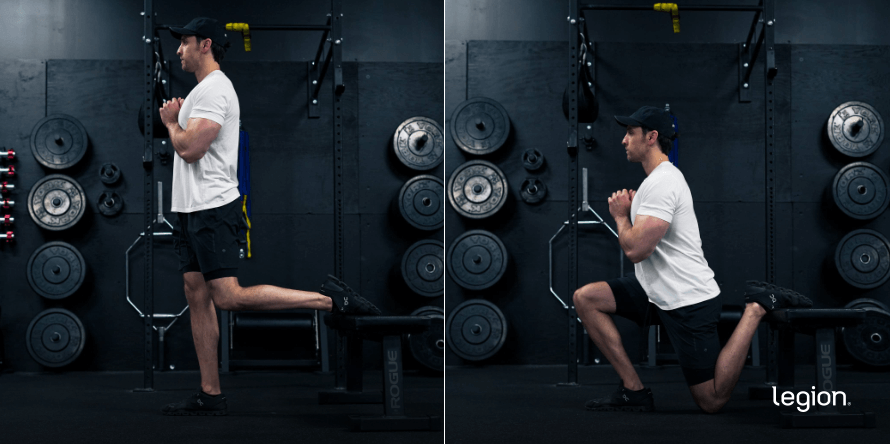
Stand about two to three feet in front of a bench, couch, or set of stairs. With your right foot (and heel in particular) firmly planted, place the top of your left foot on the surface behind you.
Look at a spot on the floor six to ten feet in front of you, and lower your butt toward the floor by bending at your right knee. Keep lowering yourself until your right thigh is roughly parallel with the floor. Then, stand up and return to the starting position.
Feet-Elevated Push-up
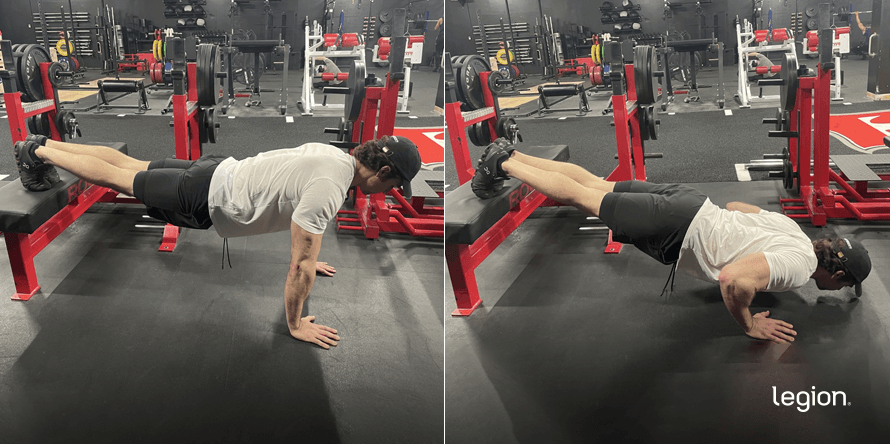
Place your hands slightly wider than shoulder-width apart and rest your toes on a bench, chair, or other surface that’s about knee-height off the floor. Straighten your back so that your body forms a straight line from your head to your feet (don’t lift up your butt or let your hips sag).
Keeping your back straight, lower your chest to the floor, and then push your body up and return to the starting position.
Bodyweight Row
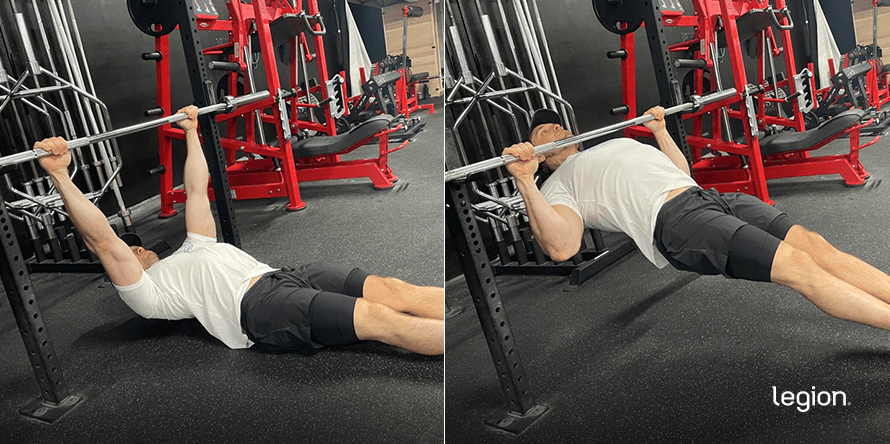
Find a surface to lie under that’s more than arm’s length off the floor (such as a table, desk, tall bench, or dip station). Grab the edge of the table or desk (or bar, if using a dip station) with your arms straight, rest your heels on the floor, and straighten your legs and back.
Keeping your back and legs straight and your butt high, pull your chest upward until your chest touches the bar (or nose, if using a desk, table, bench, etc.). Then, lower yourself to the starting position.
At-Home Full-Body Workout Routine with Exercise Bands
Using exercise bands is an excellent way to increase the intensity of your at-home workouts, allowing you to gain or maintain muscle and strength with minimal equipment.

Here’s how to do each exercise:
Banded Push-up

While holding one end of an exercise band in each hand, wrap the band around your back. Get on all fours and place your hands slightly wider than shoulder-width apart. With your arms outstretched, the band should pass just under your armpits, or over the top of your triceps.
Extend your legs behind you, so that your bodyweight is supported on your hands and toes, and your body forms a straight line from your head to your feet (don’t lift your butt up or let your hips sag).
Keeping your back straight, lower your chest to the floor, and then push your body up and return to the starting position.
Banded Horizontal Row
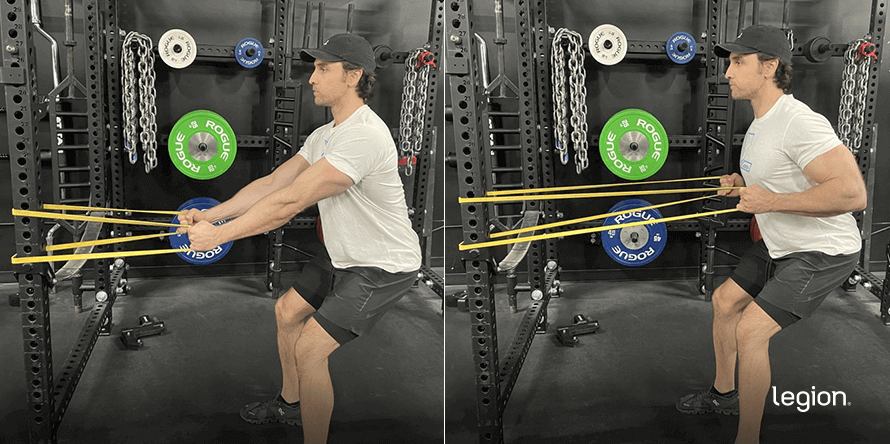
Wrap an exercise band around a sturdy post, piece of furniture, or tree at about the height of your belly button. Hold one end of the band in each hand and walk backward, allowing your arms to straighten, until all of the slack is out of the band.
Plant your feet firmly on the ground about shoulder-width apart and bend your knees slightly. Keeping your back straight, pull both hands toward your torso until they’re flush with your chest, then return to the starting position. (If you can’t get your hands to this position, take a baby-step forward to reduce the tension on the band).
Banded Single Leg Squat
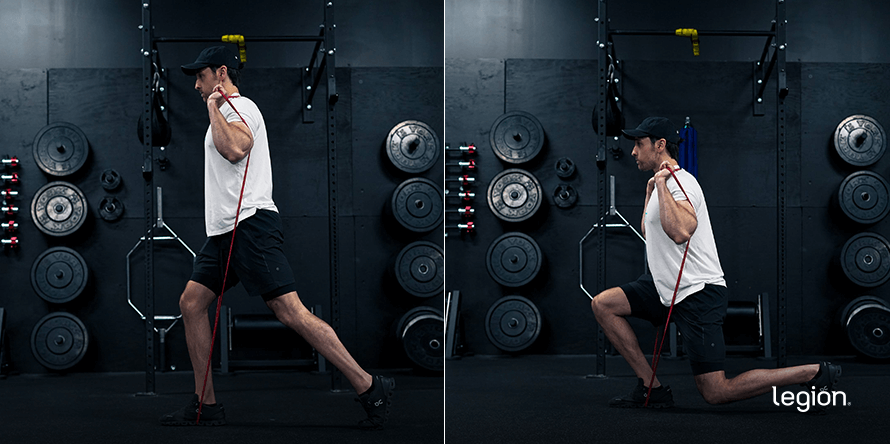
Place your right foot on an exercise band so that it lies under the middle of your foot. Bend over, grab the loose end of the exercise band, and pull it over your shoulders (you may need to bend over if it’s a strong resistance band), holding it in place with your hands.
Take a big step back with your left foot so that the ball of your foot is resting on the ground. Lower yourself until your right thigh is roughly parallel with the floor. Then, stand up and return to the starting position.
Banded Overhead Press
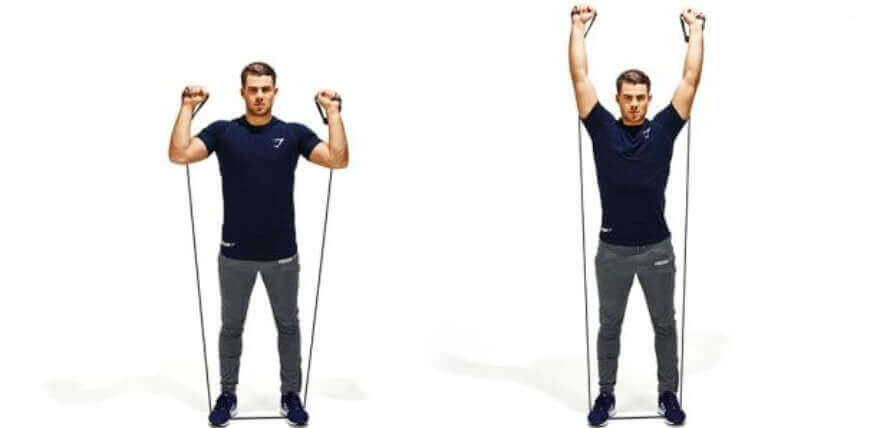
Stand on the middle of an exercise band while holding one end of it in each hand. You can stand on the band with both feet next to each other, or stagger your stance and stand on it using only one foot.
Lift your hands to your shoulders with your palms facing away from you, then press the band straight up over your head. Lower your hands to your shoulders and return to the starting position.
Banded Lat Pulldown
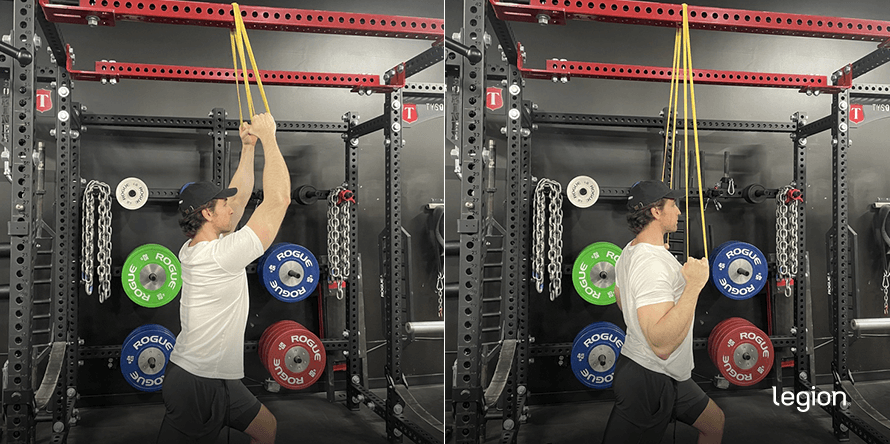
Wrap a resistance band around a pull-up bar, attic rafter, or some other point several feet above your head. Hold one end of the band in each hand and walk backward, allowing your arms to straighten, until all of the slack is out of the band.
Pull both ends of the band straight down until your hands are below your chin. Reverse the motion and return to the starting position.
At-Home Full-Body Workout Routine with Dumbbells
You don’t need barbells and machines to train your entire body hard—this workout gets the job done with a simple set of dumbbells.
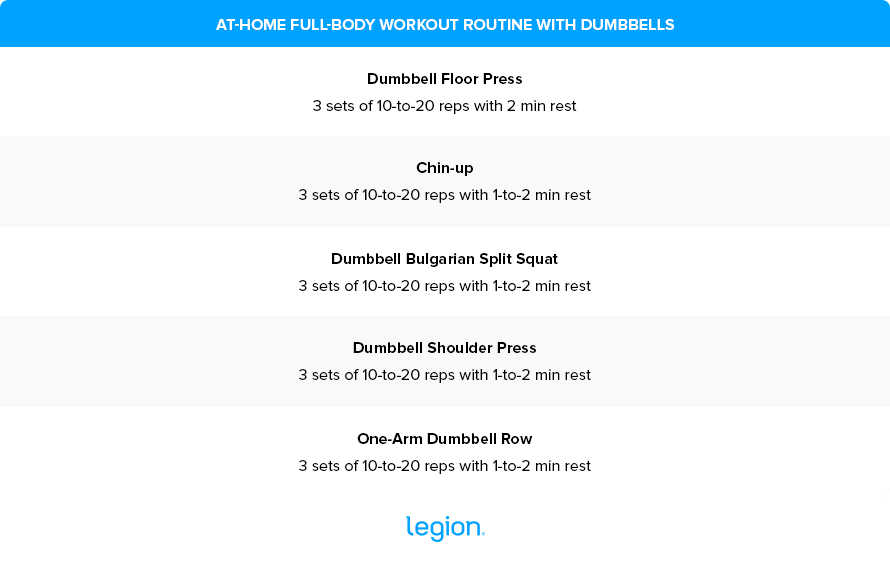
Here’s how to do each exercise:
Dumbbell Floor Press
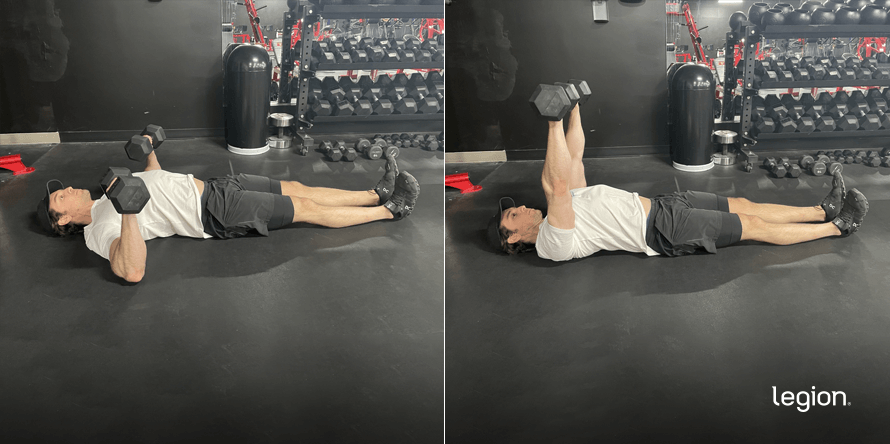
Sit on the floor and hold one dumbbell in each hand so that both of them rest vertically on top of your upper thighs. Then, lean backward slowly and gently nudge the dumbbells toward your chest with your thighs, bending your knees at the same time.
Tuck your shoulder blades down and back and push the dumbbells up until your arms are locked (some people also like to touch them together, but you don’t have to). Lower the dumbbells by reversing the motion and return to the starting position.
Chin-up

Grab a chin-up bar with your palms facing you and about shoulder-width apart and your arms straight. Without swinging your feet or your knees, pull your body upward until your chin rises above your hands, and then lower yourself to the starting position.
Dumbbell Bulgarian Split Squat
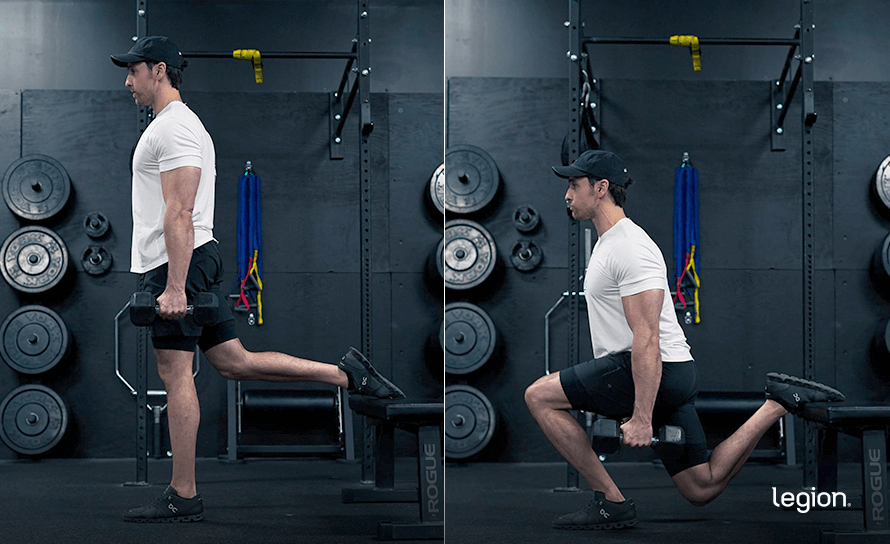
While holding a dumbbell in each hand, stand about two to three feet in front of a bench, couch, or set of stairs. With your right foot (and heel in particular) firmly planted, place the top of your left foot on the surface behind you.
Look at a spot on the floor six to ten feet in front of you, and lower your butt toward the floor by bending at your right knee. Keep lowering yourself until your right thigh is roughly parallel with the floor. Then, stand up and return to the starting position
Dumbbell Shoulder Press
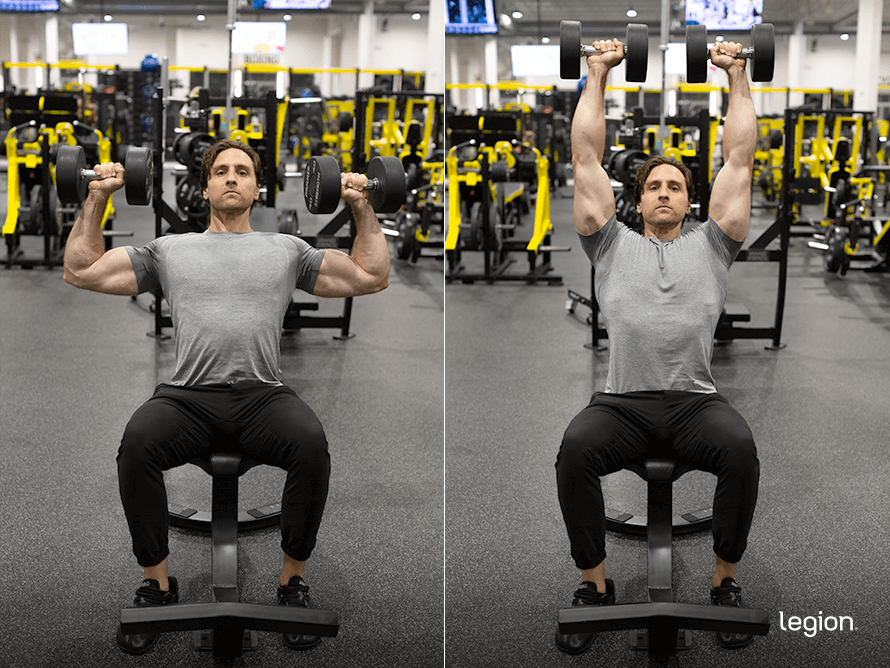
While sitting on an upright bench or on a chair with a sturdy back support, hold a dumbbell in each hand and rest them on your thighs. Hoist the dumbbells up so you’re holding them just above your shoulders with your palms facing away from you, giving them a little nudge with your thighs.
Press the dumbbells straight up over your head until your arms are straight and your elbows are locked. Then lower the dumbbells to the starting position.
One-Arm Dumbbell Row
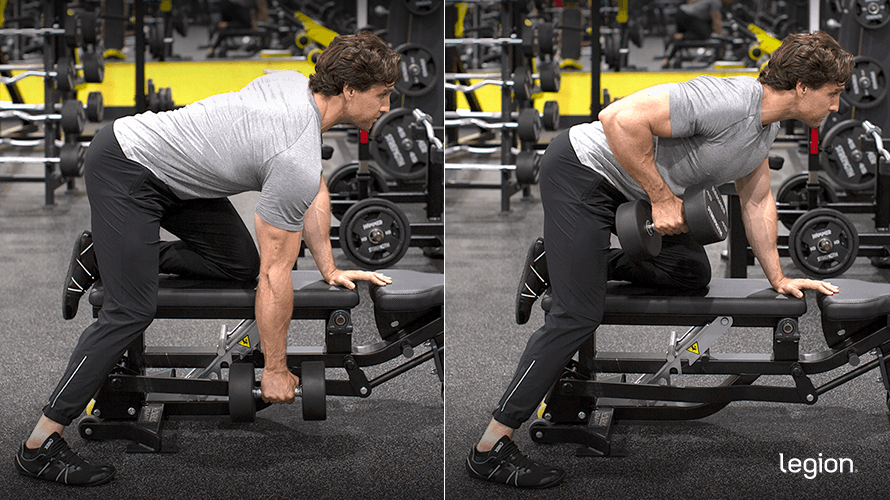
Hold a dumbbell in your right hand. Plant your left knee and arm firmly on a bench, your right foot on the floor a foot or two from the bench, and let your right arm (the one holding the dumbbell) hang straight down toward the floor).
Keeping your back straight, pull the dumbbell upward until it touches your torso, and then return the dumbbell to the starting position. Once you’ve completed the desired number of reps, repeat the process with your left arm.
Scientific References +
- Kikuchi, N., & Nakazato, K. (2017). Low-load bench press and push-up induce similar muscle hypertrophy and strength gain. Journal of Exercise Science and Fitness, 15(1), 37–42. https://doi.org/10.1016/J.JESF.2017.06.003
- Robbins, D. W., Young, W. B., Behm, D. G., & Payne, W. R. (2010). Agonist-antagonist paired set resistance training: a brief review. Journal of Strength and Conditioning Research, 24(10), 2873–2882. https://doi.org/10.1519/JSC.0B013E3181F00BFC










